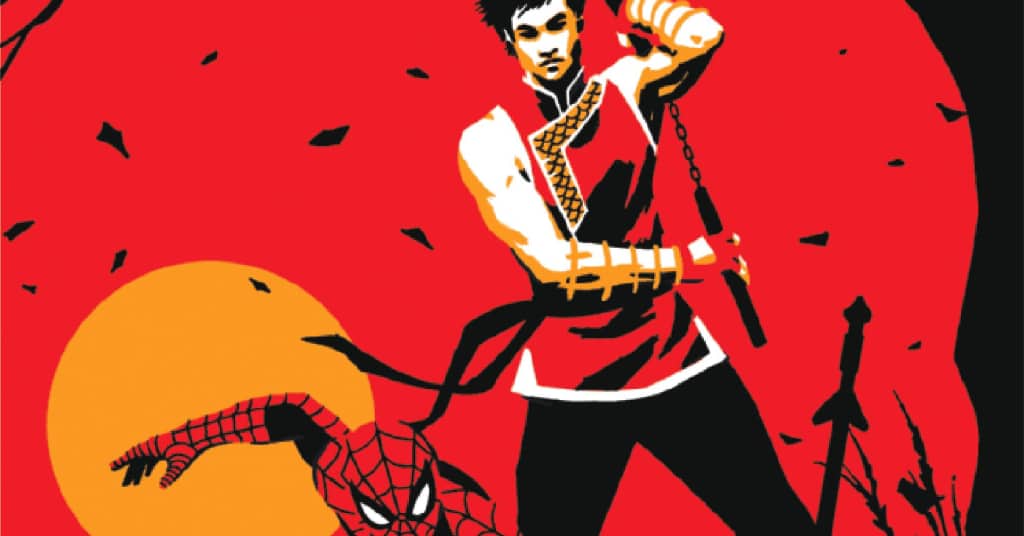Deadly Hands of Kung-Fu: Gang War #1
Recap
WHOSE SIDE ARE YOU ON? GANG WAR has thrown the crime lords and super heroes of New York into a deadly conflic,t and as both, Shang-Chi must play each side against each other in a dangerous game of deception! When he became leader of his family’s Five Weapons Society, he promised to use it for good, but friends and foes alike have been unsure of his true intentions. The stakes of Gang War will force his hand as he vows to protect Chinatown and use the opportunity to eliminate the Five Weapon Society’s biggest rivals! He’ll use his world-class fighting skills as well as deceit, calculation and manipulation to navigate the battlefields as he learns the Art of War is all about the shades of gray!
Review
Deadly Hands of Kung-Fu: Gang War #1 – written by Greg Pak with art from Caio Majado, colors from Jim Campbell, and lettering by VC’s Travis Lanham – establishes Shang-Chi’s primary conflict of the Gang War event. As Spider-Man leads his team of heroes against the warring factions of crime across New York, Shang-Chi continues his control of the Five Weapons Society, a secret group of warriors and assassins established by his father. Based in Chinatown, Shang-Chi has met with the various villains in previous installments and staked his claim to the region.
Split across two timelines, Deadly Hands of Kung-Fu reveals more information about Shang-Chi’s tense relationship with his father and brings those interactions into the present. Set against a game of strategy, Shang-Chi is taught lessons of defeating enemies with deceit and the danger of self-sacrifice. Meanwhile, in the present, Lady Yulan strikes against Chinatown with her vampire fighters, drawing the Five Weapons Society into the conflict. Spider-Man makes a detour from the main story to question Shang-Chi’s alliances and willingness to work on the darker side of the law. An affirmation of protection from Shang-Chi leads to friction from inside of the group.
Pak’s scripting for the issue is well-paced, jumping across the two timelines to strong effect. The parallel plot points make for an excellent internal dialogue, working to deepen the conflicted state in which Shang-Chi finds himself. It allows for reinforcement and exploration of the status quo that speaks to both new and returning readers. The refocus of recent Shang-Chi comics has been grappling with his family ties and his worthiness in wielding the ten rings (which got a cosmetic upgrade to bring them closer to the MCU).
That fact could have made this issue feel like a hollow constitution of that story, but instead, Pak takes the opportunity to build and deepen. Like any good tie-in, it uses the event as the catalyst but thrives in the limited focus. Shang-Chi’s internal struggle makes for a compelling centering, and the tension between Spider-Man and the various gang leaders provides an excellent engine of conflict. Those things spur the other conflict brewing inside of the Five Weapons Society, and propel the book into an excellent cliffhanger that strips Shang-Chi from supercharged Ten Ring user back to his Master of Kung Fu moniker.
The shifting tones and energy work in the scripting, but falls flat in the artwork. Majado’s linework is an excellent fit for the action sequences of the issue, delivering inventive uses of the Ten Rings. The weapons have a kinetic energy that comes partly thanks to Campbell’s golden red pulsing lights, but also through Majado’s blurring lines. The rings move and change size to dramatic effect, creating a sense of motion that syncs with the other fight choreography. Majado gets to illustrate both instances of combat in the issue and allows for the book to live up to its name.
Any energy of those fight scenes seems to disappear once the fighting starts, and instead leaves flat dialogue scenes. The paneling and angles of Majado’s talking heads lack any inventiveness or vibrancy, working to deliver dialogue and story with little flare. The sequences are clear and economical, never wasting a panel, but in that focus on getting the information across, something is drained from the issue. Even paired with Campbell’s dynamic palettes, the book is good but lacks that essence that would propel it past being just a tie-in.
Final Thoughts
Instead of being a breakout issue, Deadly Hands of Kung-Fu: Gang War #1 ends up delivering an enjoyable, if predictable, tie-in to Gang War. The book is at its best in its action sequences, or in the exploration of Shang-Chi’s inner conflicts, but falls flat in the delivery of visuals in these introspective moments. The book approaches the status of moving past being just a tie-in status but doesn’t quite reach its goal. Hopefully, the next issue will recalibrate after the establishment of the new status quo and strive to reach the highs that should come with the mantle of Master of Kung Fu.
Deadly Hands of Kung-Fu: Gang War #1: The War Inside (and Out)
- Writing - 7/107/10
- Storyline - 7/107/10
- Art - 6/106/10
- Color - 7/107/10
- Cover Art - 10/1010/10
